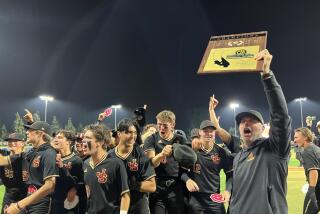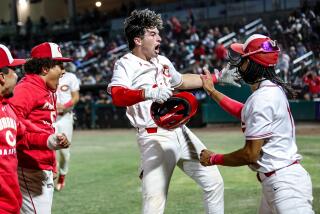Few Blacks Choosing to Play College Baseball
- Share via
OMAHA — Brian Barton grew up in South-Central Los Angeles knowing he was a minority simply by looking at the color of his skin.
It wasn’t until he began playing college baseball, though, that he realized what it really meant to be in the minority.
“Most of the teams that I played for in Little League, all the way through travel ball, were primarily made up of blacks,” said Barton, now a junior at Miami. “Most of the players on my high school team were blacks, with maybe a few Latinos.
“I was at Loyola Marymount my first year and there were two African Americans on the team. I knew that not a lot of blacks played college baseball, but coming from primarily an all-black team to being the only black was a big, big-time shock.”
Barton has been successful at Miami. As the starting center fielder, he was a leading performer for a Hurricane team that advanced to the College World Series here before being eliminated by South Carolina on Monday. This season, he batted .371 with six home runs, 46 runs batted in and 17 stolen bases.
Rangy at 6 feet 3 and 205 pounds, Barton may one day realize a dream of playing in the big leagues. But finding other blacks in the college game is becoming increasingly rare.
The decline in the number of black American players in the pros has become an issue that has drawn attention from Major League Baseball. Blacks made up 27% of the league’s players in 1964. But according to a report released by the Institute of Diversity and Ethics in Sports at the University of Central Florida, the number dropped to 19% in 1995 and to 10.8% in 2003.
Baseball is trying to address that situation. Last week, MLB teamed with the Angels and Dodgers to break ground on a baseball academy at Compton College, an idea borne out of its Reviving Baseball in the Inner Cities (RBI) program.
The announcement drew national attention to the issue, which is even more an issue in college baseball. According to the NCAA Student-Athlete Ethnicity Report, of the 9,807 baseball players in Division I last season, only 6.1% were black and 79% were white.
It was apparent here and elsewhere. Only 13 black players were among the eight teams in the College World Series. Nine black players were on the rosters of the 10 Division I schools in Southern California.
“The most that was on any opposing team we faced was one, and I had three,” said Tony Gwynn, who recently finished his second season as coach at San Diego State. “It’s troubling.”
There probably are many reasons, but the most important may be that basketball has supplanted baseball as the sport of choice for kids growing up in urban neighborhoods, particularly in Los Angeles, where Eddie Murray, Ozzie Smith, Eric Davis and Darryl Strawberry once roamed high school baseball fields.
John Young, a former major league scouting director who founded the RBI program, said there was a different mind-set among black youths.
“Kids are playing tee-ball and playing Little League at Rancho Cienega Park, but when those kids get to 12 years of age, they’re not playing,” Young said. “Basketball is really making an impact on them and there’s a Pied Piper in the community where all the kids gravitate to because they have the energy to steer them along.
“In basketball, there is a financial reward for doing that. There isn’t someone like that for baseball.”
Statistics point out the influence of basketball and football. For example, blacks made up 57.9% of all basketball players in Division I and 45.1% in football.
Barton played at Westchester High, a school better known for its nationally recognized basketball program than baseball. He said he got plenty of support from his family and friends, but classmates would be surprised that he was on the baseball team.
“Because of my height, a lot of people would look at me and wonder why I didn’t play basketball,” he said. “I always tell them that [baseball] was something I wanted to do since I was little.”
Ozzie Smith is surprised that college baseball isn’t more appealing to young black athletes. Barton was one of the few starting players on the teams in the College World Series, and there were no college superstars such as Barry Bonds, Albert Belle or Barry Larkin, all of whom led their teams to Omaha before going on to success in the major leagues.
“College programs today are such that the kids are being taught the game very well,” said the Hall of Fame shortstop, who attended Cal Poly San Luis Obispo. “It’s very much like a low minor league system.
“Part of the problem is, young kids today are looking for the quick fix. Unless you are one of the players that can make an impact right away, it is a long process.”
Gwynn said that college programs had to find the best players available because they needed to produce results on the scoreboard.
What is unfortunate, he says, is that the polished players are mostly a product of high school and travel teams in the suburbs and many black families either do not have or cannot afford access to quality programs.
Because of that, Gwynn notes that a growing number of current black college players are sons of major leaguers, such as South Carolina freshman David Cash or Stanford sophomore John Mayberry Jr.
Gwynn’s own son, Anthony, played at San Diego State and is in the minors.
“Everything is a travel league,” Gwynn said. “Baseball, basketball, football. It costs money. And when it costs money, lots of African American families don’t have the same opportunities as other families. It sounds corny but it’s a legitimate issue.”
Ray Tanner, the baseball coach at South Carolina, said the lack of black players was a concern and agreed that the cost of baseball can be an issue. He put part of the blame on the NCAA allotment of 11.7 scholarships as a detriment to high school players.
Tanner said he and other coaches had to spread the scholarships among 30 to 35 players with usually 30% of one being the most given to one individual.
“We give our partial scholarships and we just don’t have as many,” he said. “In football and basketball, they get full rides. For talented athletes who play baseball and may like baseball, they may go the other way because of the opportunity to have their education paid for.”
Gwynn said there were plenty of blacks playing in youth leagues and high school, but that the lure of signing bonuses often kept those players from reaching college campuses.
He said he saw up to 15 black players last summer at the Area Code Games, a showcase for many of the top high school players in the nation, but he didn’t see most of them on college rosters this season.
“I got a couple of commitments this year, but they both got drafted and they signed,” Gwynn said.
“You can either sign out of high school or go to college and not get drafted again for another three years. Honestly, I don’t think a lot of kids want to wait that long.”
Barton, the Miami outfielder, said colleges could do more to recruit black players. He said that his own experiences have been mostly beneficial but added that some coaches had built-in perceptions and often turned to recruiting a player of another race.
“I felt I was overlooked by a lot of teams,” he said. “The only offer I got out of high school was from San Jose State. I saw a lot of people who were getting scholarships and money and I felt I could compete at the same level.
“I think there’s a misconception that a lot of the African American players have a lot of attitude and they’re tough to deal with or can’t be coached. I say, give them a chance and let them prove themselves.”
*
(BEGIN TEXT OF INFOBOX)
Dwindling Numbers
A breakdown of black players on college baseball teams:
LOCAL COLLEGES
* UCLA -- OF Anthony Norman, OF Jarrad Page, P Adam Simon
* USC -- None.
* UC Santa Barbara -- None.
* UC Riverside -- None.
* Cal State Northridge -- None.
* Cal State Fullerton -- OF Bobby Andrews
* Long Beach State -- P Romeo Newman
* Loyola Marymount -- OF James Cooper
* Pepperdine -- None.
* UC Irvine -- P Glenn Swanson, OF David Kennedy, OF Herman Reddick
COLLEGE WORLD SERIES
* South Carolina -- OF Mark Stanley, IF David Cash, DH Nick Gardiner, OF John Adams
* Miami -- OF Brian Barton
* Texas -- None.
* Georgia -- OF Jonathan Wyatt
* Arkansas -- OF Kern Watts*
* Fullerton -- OF Bobby Andrews
* Louisiana State -- DH Quinn Stewart**
* Arizona -- IF Lee Franklin, OF D.J. Lewis, OF Terrence Taylor, P Donald Veal
2003 NUMBERS
* Number of players in college baseball: 9,807
* Number of black college players: 588
* Pct. of blacks in college baseball: 6.1%
* Pct. of blacks in college basketball: 57.9%
* Pct. of blacks in college football: 45.1%
*-Watts is a native of Brampton, Ontario; **-redshirted the 2004 season
Source: NCAA Student-Athlete Ethnicity Report
More to Read
Go beyond the scoreboard
Get the latest on L.A.'s teams in the daily Sports Report newsletter.
You may occasionally receive promotional content from the Los Angeles Times.










